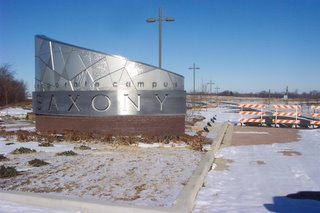Why Libertarian?Libertarians believe in the best possible use for public resources. Libertarians believe that transportation is a private matter, to be paid for in full by the person using the transportation. Libertarians are unwilling to fund expensive pie-in-the-sky marginal solutions to large problems.
This stands in contrast with Hamilton County Republicans, who take the opposite position of Libertarians on light rail and mass transit. Of course, they would never say that they are for the worst use of resources, or for pie-in-the sky, but actions matter. Republicans are acting to make the least of the Nickel Plate route, and launch a painfully expensive boondoggle.
The Nickel Plate line is being eyed as a starter route for a light rail mass transit network. The cost would be conservatively $850, and more likely better than a billion dollars. This network has been touted to take a maximum of 4% of cars off of I-69. Four percent!!!
Republican Hamilton County Commissioner Christine Altman has repeatedly spoken on record in favor of spending around a billion dollars for this starter system. The latest quotes can be found in a December 16 article in
the Noblesville Ledger, under the headline,
"Official wants mass transit sooner than later":
The three proposed routes for mass transit's initial route in the region are along the old Nickel Plate Road rail line in Fishers and near Allisonville Road and Interstate 69. The possible forms of mass transit are high-tech express buses, trolley-style light rail or an elevated electric train.
Estimates have placed design and construction costs at $850 million.
"We are strongly exploring ways to bring this out more rapidly," Altman said, noting that one way would be to use all local funding instead of asking the federal government for help. She wants to talk with the Indiana General Assembly about the importance of regional transportation, in the hopes they will approve a regional tax.
Carmel's Republican Mayor Jim Brainard recently addressed Hamilton County Democrats to show affinity between the two parties on this issue. It is worth noting that neither I-69 nor the Nickel Plate line run through Carmel. It is also worth noting that the Monon Trail, a former Monon Railroad line that does run through Carmel, has not been offered for a conversion to light rail. Likewise, Altman represents Clay Township, which is to say, Carmel.
Best Management of Resources. The Monon, like the Nickel Plate, was a former freight railroad. The passenger traffic dried up by the late 1950s on the Monon, and by World War 2 on the Nickel Plate. That should tell you a lot about the viability of rail on these routes. As the freight traffic withered in the 1960s, the lines became run down, and adjacent property values suffered. In Carmel and Indianapolis, the Monon was converted to a trail and greenway. Property values skyrocketed, as the adjacent areas went from undesirable to hot property.
You won't find anyone near the Monon willing to reconvert it back to rail. It would crush their property values. So, why not convert the Nickel Plate into a greenway and trail, and let it do for Fishers and Indianapolis in the areas parallel to Binford Blvd. what Monon did for Carmel? Does this make too much sense?
Unfortunately, Republican officials are trying to solve one problem, congestion on I-69, by squandering a precious resource. The best use for the Nickel Plate corridor is obviously a greenway and trail, but their judgment is clouded by the desire to use it to solve a problem.
Only the Libertarian Party has made the policy proposal to convert the Nickel Plate into a trail and greenway. I hope to help cause this issue to gain traction shortly.
Transportation is a Private Matter. You would expect Republican officials to agree with this statement, and yet, they seem bent on backing the expansion of public transportation. Some argue that the person riding the train pays a fare, and therefore pays his way. If IndyGo is any model for comparison, and I think it is, then riders get a virtual free ride. From page 9 of
IndyGo financial statements for 2002, here's where the revenue came from:
16% Passenger Fares
30% Property & Excise Taxes
26% Federal Assistance
26% Municipalities
1% Charters and Special Services
1% Other Revenue
In other words, 82% of IndyGo's 2002 operating revenues came from taxes. It's virtually a free ride for the passengers. There's more.
In 2000, IndyGo lost $5.2 million.
In 2001, IndyGo lost $3.4 million.
In 2002, IndyGo lost $4.0 million.
In 2003, IndyGo showed a profit of $2.8 million.
So, people really started riding the bus, right? No. According the
2003 IndyGo financial statement, fares only increased by $400,000. So how was there a swing of $6.8 million? In a word, taxes.
In 2003, Federal assistance increased by $1.8 million, and local assistance increased by $2.2 million. You will recall that property tax re-assessments were made, with assessed values rising dramatically. As these values soared, the taxes received by IndyGo did likewise.
It's startling to consider how significant the tax support is for IndyGo when you consider just this one line item, found on page 26 of the 2003 statement:
Prior to the collection of taxes, IndyGo had an operating loss of $37.4 million. Fares only provided $6.3 million in income.
That's a lot of tax money to cover. And yet, it happened. This is what Hamilton County Republicans are fixing to bring to us- the reinvention of Marion County. Why on earth would we want this? Answer: we don't.
To date, I have not heard a single Republican official speak out against a mass transit boondoggle such as the proposed Nickel Plate light rail starter system. I have heard Commissioner Altman, Mayor Brainard, Noblesville Mayor Ditslear, and State Senator Luke Kenley -all Republicans- speak in favor of it.
Big Difference. This issue is one of many that illustrates the difference between Republicans and Libertarians. Republicans give lip services to smaller government and lower taxes, but act in an opposite fashion. Elect Libertarians, and you will see officials who will call this what it is- bad public policy. Elect Libertarians, and we would make sure it would not come to pass.
Here are links to some of my previous posts on this issue:
1,
2,
3,
4.





